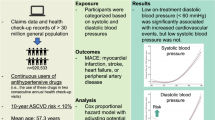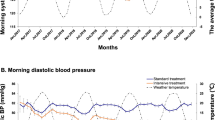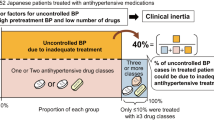Abstract
Hypertension and diabetes mellitus frequently occur together, leading to increased complications and mortality in patients with both these conditions. Blood pressure (BP) goals for patients with diabetes have consistently been more aggressive than for patients without diabetes. Although the benefits of lowering BP are well documented, data to support this more aggressive goal are lacking. In fact, lowering BP might not always be better. We review the available evidence regarding BP treatment in patients with hypertension and diabetes from randomized clinical trials, as well as available observational data. We also consider evidence related to the J-shaped curve, which reflects the relationship between BP and outcomes in patients with diabetes, and make recommendations for treatment of BP on the basis of a patient's individual risk, as opposed to on the basis of aggressive BP targets recommended by global guidelines. In the future, a personalized approach will maximize the benefits from treatment.
Key Points
-
Diabetes mellitus and hypertension are common comorbid conditions, and are associated with morbidity and mortality related to vascular disease
-
Blood pressure (BP) lowering is associated with reduction in cardiovascular-related morbidity and mortality
-
Current guidelines recommend a BP goal of <130/80 mmHg in patients with diabetes despite lack of evidence from clinical trials to support this goal
-
A J-shaped relationship exists between BP and cardiovascular risk, which seems to be most profound in patients with cardiovascular disease
-
Risk management in a patient with diabetes should include selection of a BP-lowering goal that is based on individual level of risk, together with an approach that focuses on the patient as a whole
-
Lowering BP to <140/90 mmHg in all patients, regardless of diabetes status, is warranted on the basis of current evidence
This is a preview of subscription content, access via your institution
Access options
Subscribe to this journal
Receive 12 print issues and online access
$209.00 per year
only $17.42 per issue
Buy this article
- Purchase on Springer Link
- Instant access to full article PDF
Prices may be subject to local taxes which are calculated during checkout

Similar content being viewed by others
References
Stamler, J., Vaccaro, O., Neaton, J. D. & Wentworth, D. Diabetes, other risk factors, and 12-yr cardiovascular mortality for men screened in the Multiple Risk Factor Intervention Trial. Diabetes Care 16, 434–444 (1993).
Sowers, J. R., Epstein, M. & Frohlich, E. D. Diabetes, hypertension, and cardiovascular disease: an update. Hypertension 37, 1053–1059 (2001).
[No authors listed] The 1984 Report of the Joint National Committee on Detection, Evaluation, and Treatment of High Blood Pressure. Arch. Intern. Med. 144, 1045–1057 (1984).
[No authors listed] The fifth report of the Joint National Committee on Detection, Evaluation, and Treatment of High Blood Pressure (JNC V). Arch. Intern. Med. 153, 154–183 (1993).
[No authors listed] The sixth report of the Joint National Committee on Prevention, Detection, Evaluation, and Treatment of High Blood Pressure. Arch. Intern. Med. 157, 2413–2446 (1997).
Chobanian, A. V. et al. The Seventh Report of the Joint National Committee on Prevention, Detection, Evaluation, and Treatment of High Blood Pressure: the JNC 7 report. JAMA 289, 2560–2572 (2003).
Mancia, G. et al. 2007 Guidelines for the management of arterial hypertension: The Task Force for the Management of Arterial Hypertension of the European Society of Hypertension (ESH) and of the European Society of Cardiology (ESC). Eur. Heart J. 28, 1462–1536 (2007).
American Diabetes Association. Treatment of hypertension in adults with diabetes. Diabetes Care 25, 199–201 (2002).
Hansson, L. et al. Effects of intensive blood-pressure lowering and low-dose aspirin in patients with hypertension: principal results of the Hypertension Optimal Treatment (HOT) randomised trial. HOT Study Group. Lancet 351, 1755–1762 (1998).
[No authors listed] Tight blood pressure control and risk of macrovascular and microvascular complications in type 2 diabetes: UKPDS 38. UK Prospective Diabetes Study Group. BMJ 317, 703–713 (1998).
Cushman, W. C. et al. Effects of intensive blood-pressure control in type 2 diabetes mellitus. N. Engl. J. Med. 362, 1575–1585 (2010).
Cooper-DeHoff, R. M. et al. Tight blood pressure control and cardiovascular outcomes among hypertensive patients with diabetes and coronary artery disease. JAMA 304, 61–68 (2010).
International Diabetes Federation. About diabetes [online], (2010).
Wild, S., Roglic, G., Green, A., Sicree, R. & King, H. Global prevalence of diabetes: estimates for the year 2000 and projections for 2030. Diabetes Care 27, 1047–1053 (2004).
Kannel, W. B., Wilson, P. W. & Zhang, T. J. The epidemiology of impaired glucose tolerance and hypertension. Am. Heart J. 121, 1268–1273 (1991).
Klein, R., Klein, B. E., Lee, K. E., Cruickshanks, K. J. & Moss, S. E. The incidence of hypertension in insulin-dependent diabetes. Arch. Intern. Med. 156, 622–627 (1996).
Fryar, C. D., Hirsch, R., Eberhardt, M. S., Yoon, S. S. & Wright, J. D. Hypertension, high serum total cholesterol, and diabetes: racial and ethnic prevalence differences in U.S. adults, 1999–2006 [online], (2010).
Mancia, G. The association of hypertension and diabetes: prevalence, cardiovascular risk and protection by blood pressure reduction. Acta Diabetol. 42 (Suppl. 1), S17–S25 (2005).
Creager, M. A., Lüscher, T. F., Cosentino, F. & Beckman, J. A. Diabetes and vascular disease: pathophysiology, clinical consequences, and medical therapy: Part I. Circulation 108, 1527–1532 (2003).
Haffner, S. M., Lehto, S., Rönnemaa, T., Pyörölä, K. & Laakso, M. Mortality from coronary heart disease in subjects with type 2 diabetes and in nondiabetic subjects with and without prior myocardial infarction. N. Engl. J. Med. 339, 229–234 (1998).
Stern, M. P. Diabetes and cardiovascular disease. The “common soil” hypothesis. Diabetes 44, 369–374 (1995).
Redon, J. et al. Mechanisms of hypertension in the cardiometabolic syndrome. J. Hypertens. 27, 441–451 (2009).
Cooper, S. A. et al. Renin-angiotensin-aldosterone system and oxidative stress in cardiovascular insulin resistance. Am. J. Physiol. Heart Circ. Physiol. 293, H2009–H2023 (2007).
Lewington, S., Clarke, R., Qizilbash, N., Peto, R. & Collins, R. Age-specific relevance of usual blood pressure to vascular mortality: a meta-analysis of individual data for one million adults in 61 prospective studies. Lancet 360, 1903–1913 (2002).
Adler, A. I. et al. Association of systolic blood pressure with macrovascular and microvascular complications of type 2 diabetes (UKPDS 36): prospective observational study. BMJ 321, 412–419 (2000).
Avins, A. L. When clinical practice guidelines meet the black box. Arch. Intern. Med. 170, 1013–1014 (2010).
[No authors listed] Effects of ramipril on cardiovascular and microvascular outcomes in people with diabetes mellitus: results of the HOPE study and MICRO-HOPE substudy. Heart Outcomes Prevention Evaluation Study Investigators. Lancet 355, 253–259 (2000).
American Diabetes Association. Standards of medical care for patients with diabetes mellitus. Diabetes Care 25, 213–229 (2002).
American Diabetes Association. Standards of medical care in diabetes—2010. Diabetes Care 33 (Suppl. 1), S11–S61 (2010).
Chobanian, A. V. et al. Seventh report of the Joint National Committee on Prevention, Detection, Evaluation, and Treatment of High Blood Pressure. Hypertension 42, 1206–1252 (2003).
Cushman, W. C. et al. Rationale and design for the blood pressure intervention of the Action to Control Cardiovascular Risk in Diabetes (ACCORD) trial. Am. J. Cardiol. 99, 44i–55i (2007).
Yusuf, S. et al. Effects of an angiotensin-converting-enzyme inhibitor, ramipril, on cardiovascular events in high-risk patients. The Heart Outcomes Prevention Evaluation Study Investigators. N. Engl. J. Med. 342, 145–153 (2000).
Braunwald, E. et al. Angiotensin-converting-enzyme inhibition in stable coronary artery disease. N. Engl. J. Med. 351, 2058–2068 (2004).
Heart Protection Study Collaborative Group. MRC/BHF Heart Protection Study of cholesterol lowering with simvastatin in 20,536 high-risk individuals: a randomised placebo-controlled trial. Lancet 360, 7–22 (2002).
Curb, J. D. et al. Effect of diuretic-based antihypertensive treatment on cardiovascular disease risk in older diabetic patients with isolated systolic hypertension. Systolic Hypertension in the Elderly Program Cooperative Research Group. JAMA 276, 1886–1892 (1996).
Staessen, J. A. et al. Randomised double-blind comparison of placebo and active treatment for older patients with isolated systolic hypertension. The Systolic Hypertension in Europe (Syst-Eur) Trial Investigators. Lancet 350, 757–764 (1997).
Tuomilehto, J. et al. Effects of calcium-channel blockade in older patients with diabetes and systolic hypertension. Systolic Hypertension in Europe Trial Investigators. N. Engl. J. Med. 340, 677–684 (1999).
Patel, A. et al. Effects of a fixed combination of perindopril and indapamide on macrovascular and microvascular outcomes in patients with type 2 diabetes mellitus (the ADVANCE trial): a randomised controlled trial. Lancet 370, 829–840 (2007).
Holman, R. R., Paul, S. K., Bethel, M. A., Neil, H. A. & Matthews, D. R. Long-term follow-up after tight control of blood pressure in type 2 diabetes. N. Engl. J. Med. 359, 1565–1576 (2008).
Schrier, R. W., Estacio, R. O. & Jeffers, B. Appropriate Blood Pressure Control in NIDDM (ABCD) Trial. Diabetologia 39, 1646–1654 (1996).
Estacio, R. O. et al. The effect of nisoldipine as compared with enalapril on cardiovascular outcomes in patients with non-insulin-dependent diabetes and hypertension. N. Engl. J. Med. 338, 645–652 (1998).
Schrier, R. W., Estacio, R. O., Esler, A. & Mehler, P. Effects of aggressive blood pressure control in normotensive type 2 diabetic patients on albuminuria, retinopathy and strokes. Kidney Int. 61, 1086–1097 (2002).
Lewis, E. J. et al. Renoprotective effect of the angiotensin-receptor antagonist irbesartan in patients with nephropathy due to type 2 diabetes. N. Engl. J. Med. 345, 851–860 (2001).
Berl, T. et al. Impact of achieved blood pressure on cardiovascular outcomes in the Irbesartan Diabetic Nephropathy Trial. J. Am. Soc. Nephrol. 16, 2170–2179 (2005).
Pepine, C. J. et al. A calcium antagonist vs a non-calcium antagonist hypertension treatment strategy for patients with coronary artery disease. The International Verapamil-Trandolapril Study (INVEST): a randomized controlled trial. JAMA 290, 2805–2816 (2003).
Chew, E. Y. et al. Effects of medical therapies on retinopathy progression in type 2 diabetes. N. Engl. J. Med. 363, 233–244 (2010).
[No authors listed] The 1988 report of the Joint National Committee on Detection, Evaluation, and Treatment of High Blood Pressure. Arch. Intern. Med. 148, 1023–1038 (1988).
American Diabetes Association. Diabetic nephropathy. Diabetes Care 25 (Suppl. 1), S85–S88 (2002).
Mancia, G. et al. Reappraisal of European guidelines on hypertension management: a European Society of Hypertension Task Force document. J. Hypertens. 27, 2121–2158 (2009).
Turnbull, F. et al. Effects of different blood pressure-lowering regimens on major cardiovascular events in individuals with and without diabetes mellitus: results of prospectively designed overviews of randomized trials. Arch. Intern. Med. 165, 1410–1419 (2005).
Mancia, G. et al. 2007 ESH-ESC Practice Guidelines for the Management of Arterial Hypertension: ESH-ESC Task Force on the Management of Arterial Hypertension. J. Hypertens. 25, 1751–1762 (2007).
Jamerson, K. et al. Benazepril plus amlodipine or hydrochlorothiazide for hypertension in high-risk patients. N. Engl. J. Med. 359, 2417–2428 (2008).
Weber, M. A. et al. Cardiovascular events during differing hypertension therapies in patients with diabetes. J. Am. Coll. Cardiol. 56, 77–85 (2010).
Cruickshank, J. M., Thorp, J. M. & Zacharias, F. J. Benefits and potential harm of lowering high blood pressure. Lancet 1, 581–584 (1987).
Alderman, M. H., Ooi, W. L., Madhavan, S. & Cohen, H. Treatment-induced blood pressure reduction and the risk of myocardial infarction. JAMA 262, 920–924 (1989).
Farnett, L., Mulrow, C. D., Linn, W. D., Lucey, C. R. & Tuley, M. R. The J-curve phenomenon and the treatment of hypertension. Is there a point beyond which pressure reduction is dangerous? JAMA 265, 489–495 (1991).
Grossman, E. Does the 'J-curve' still hold in the post 'HOT' era? J. Hum. Hypertens. 12, 729–730 (1998).
Ibsen, H. Intensive blood pressure lowering warranted. Results of the HOT study: an epitaph for the J-curve concept in hypertension. J. Hum. Hypertens. 12, 731–732 (1998).
Messerli, F. H. et al. Dogma disputed: can aggressively lowering blood pressure in hypertensive patients with coronary artery disease be dangerous? Ann. Intern. Med. 144, 884–893 (2006).
Bakris, G. L. et al. Clinical outcomes in the diabetes cohort of the International Verapamil SR-Trandolapril study. Hypertension 44, 637–642 (2004).
Rönnback, M. et al. Complex relationship between blood pressure and mortality in type 2 diabetic patients: a follow-up of the Botnia Study. Hypertension 47, 168–173 (2006).
van Hateren, K. J. et al. Lower blood pressure associated with higher mortality in elderly diabetic patients (ZODIAC-12). Age Ageing 39, 603–609 (2010).
Timbie, J. W., Hayward, R. A. & Vijan, S. Variation in the net benefit of aggressive cardiovascular risk factor control across the US population of patients with diabetes mellitus. Arch. Intern. Med. 170, 1037–1044 (2010).
Hansson, L. & Zanchetti, A. The Hypertension Optimal Treatment (HOT) Study—patient characteristics: randomization, risk profiles, and early blood pressure results. Blood Press. 3, 322–327 (1994).
Ginsberg, H. N. et al. Effects of combination lipid therapy in type 2 diabetes mellitus. N. Engl. J. Med. 362, 1563–1574 (2010).
Boyle, J. P. et al. Projection of diabetes burden through 2050: impact of changing demography and disease prevalence in the U.S. Diabetes Care 24, 1936–1940 (2001).
Author information
Authors and Affiliations
Contributions
R. M. Cooper-DeHoff contributed to discussion of content for the article, researched data to include in the manuscript, wrote the article, reviewed and edited the manuscript before submission, and revised the manuscript in response to the peer-reviewers' comments. E. F. Egelund researched data to include in the manuscript and wrote the article. C. J. Pepine contributed to discussion of content for the article and reviewed and edited the manuscript before submission.
Corresponding author
Ethics declarations
Competing interests
C. J. Pepine has received grants from AstraZeneca, AtCor Medical, Baxter, Bioheart, Daiichi Sankyo, Eli Lilly, GlaxoSmithKline, Pfizer, Sanofi-Aventis, and Schering-Plough. He is a consultant for Abbott Laboratories, Angioblast Systems, Forest Laboratories, Medtelligence, NicOx, Novartis, Sanofi-Aventis, and SLACK Incorporated. R. M. Cooper-DeHoff and E. F. Egelund declare no competing interests.
Rights and permissions
About this article
Cite this article
Cooper-DeHoff, R., Egelund, E. & Pepine, C. Blood pressure lowering in patients with diabetes—one level might not fit all. Nat Rev Cardiol 8, 42–49 (2011). https://doi.org/10.1038/nrcardio.2010.182
Published:
Issue Date:
DOI: https://doi.org/10.1038/nrcardio.2010.182
This article is cited by
-
The goal of blood pressure in the hypertensive patient with diabetes is defined: now the challenge is go from recommendations to practice
Diabetology & Metabolic Syndrome (2014)
-
Changes in body weight and blood pressure: paradoxical outcome events in overweight and obese subjects with cardiovascular disease
International Journal of Obesity (2014)
-
Blood Pressure J-Curve: Current Concepts
Current Hypertension Reports (2012)



